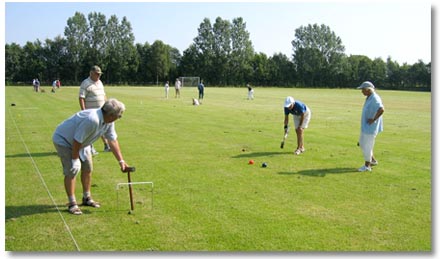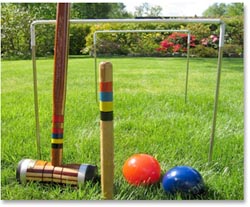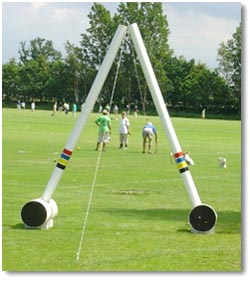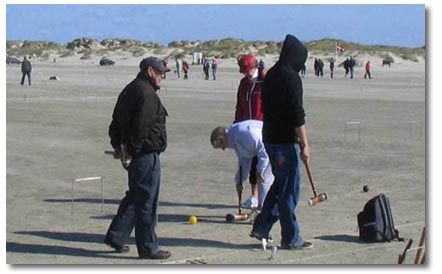
|
Back to |
| The Front Page |
| The Game |
|
Croquet in Denmark: What can they teach us? |
||||||
|
By Kirsten Bjarnholt with Bob Alman Photos courtesy of Kirsten Bjarnholt Posted July 21, 2010
|
||||||
|
||||||
One in a thousand citizens of Denmark pay annual dues to play croquet. The same proportion in the US would produce 300,000 due-paying members. Do the Danes know something the rest of us don't know? In the beginning, croquet in Denmark was played in private gardens as a casual amusement for the family, just as the game started in the British Commonwealth countries in the 19th Century. But in 1960 in the south of Jutland some small cities started to organize, first locally, then regionally. As clubs started competing against each other and agreeing to compromises on rules and conventions, the game began to develop beyond its rude grassroots. In 1962, agreements were made on boundary markings, and a most momentous decision was made about the stroke: it must always be made using only one hand on the mallet.
Twenty years of development produces a single national game
By 1972 a man named Svend Aage Christensen, chairman of the nine clubs in the southwest of Jutland, had managed to codify rules that would become the basis of the national game. It wasn't until 1986 that the first county-wide tournament took place, with 20 teams from the 9 clubs participating, but soon after that, clubs in other counties imitated the Jutland example, and a common game began to spread throughout Denmark.

|
A critical development in 1992 completed the main outline of the development of the sport in Denmark. That was when croquet became a member of DGI (Danske Gymnastik-og Idraetsforeninger), one of three government agencies that helps the development of sports and leisure groups through administrative structures, national promotion of events, training courses and the like. Croquet's National Committee produces the material for courses to train instructors. Thirteen of Denmark's 14 counties now have a county committee who meet once a year with the National Committee to regulate and organize the sport nationally. In little Denmark, with a population of about 5,500,000, there are 226 clubs with roughly 5,000 players. Most of the clubs are playing on football pitches or other multi-purpose lawns, but a few clubs have their own lawn dedicated for croquet.
Openshaw's sense of the game
David Openshaw first visited Denmark to play croquet in 2006, when he and three other representatives from European countries attended the giant festival of all the DGI organization's sports held every three or four years to demonstrate Association and Golf Croquet. They were suitably impressed. Openshaw went back in 2009 to actually compete in a doubles event that is part of a huge sports festival DGI produces every three or four years.
Based on his experience in that event - which he did not win - he's very emphatic in saying , "It's not backyard croquet. The reason is that there has been quite a lot of development in the rules and layout of the lawn," all standardized, just as in the major Federation countries. In Openshaw's view, because the Danes have a well-organized schedule of local, regional and national tournaments, standardized rules and court setting, and ongoing training programs, "It's just as developed as Association Croquet or American Rules. The only difference is that it's appropriate to play the game on any quality of grass."
And more important, according to Openshaw, "The Danish game requires good shot-making ability and sound strategic skills."
It looks the same - but it's not
|
THE DIFFERENCE IN THE DANISH WAY |
| Although tournaments are played and refereed with the same kind of rigor as in other WCF countries, and there's a national agenda directed to ongoing training of referees and instructors, the Danes keep everything as simple as possible.
• The hoops are W I D E - more than three times the circumference of the balls. The Danes apparently believe that people enjoy shooting hoops, and they shoot more of them if they're wide. • They don't bother with hoop clips. • Double-banking is seldom necessary and rarely done. • There is no carry-over deadness and no deadness boards. • They play to the peg, so clocks are unnecessary. • Although players enjoy smooth courts, any agreed-upon playing surface is fine, and most commonly used are soccer pitches. • The mallets and balls are light, but not as light as flimsy backyard sets sold in discount stores. • All shots must be taken one-handed. • Did we mention that the hoops are W I D E ?
|
The court is very similar to the garden court of the 19th Century, with some startling differences: to make the turning peg more difficult, it has been put into "C" corner. And the side hoops are very close to boundaries, which tempts players to try for one-ball breaks by shooting from near the boundary through the hoop to position at the next hoop. And as proof of the thoughtful evolution of the game in Denmark, the games are always played as a four-ball game, with red and yellow as partners against blue and black - there is none of the chaos that developed in 19th century backyards, with three- and four-ball teams; and no "cut-throat" every-man-for-himself games still played in the US and other countries.
THE EQUIPMENT IS LIGHT AND THE HOOPS ARE WIDE

|
| One recent development in equipment is in the recommended mallet design, which now has hard plastic on one face of the mallet head and rubber on the other, producing the effect of the roll shot. |
How the game is played

|
After the leading team have been all the way through the course of hoops and have run the 14th hoop, they have to roquet all the other balls to be able to finish the game and thereby win the game by scoring 20 points. (This is somewhat in the spirit of "poison" in backyard or garden croquet.)
The point-system goes like this: The player gets 1 point for hitting the peg in corner C (called the turning peg). Then the player gets 2 points for running hoop 11, next the player gets 3 points for running hoop 13 and 14 without hitting the peg behind hoop 14. (If a player hits this start/finish peg directly after scoring hoop 14, that player has to start over from hoop 8). After running hoop 14 the player must roquet all the other balls. When this is done and his partner has done the same the couple gets 4 points. To finish the game the two balls must hit the finishing peg and achieve the last 4 points (per couple). The total points for winning the game are 20 points.
Every summer the 13 counties have tournament for couples and for teams. The winning couple and winning team from these counties are then invited to compete against the winners from the other counties to find each year's national champion for couple and team.
There is no rigid dress code for tournament play. Note the striker bracing his body above the left knee while striking with the right hand. Also note that there is no etiquette requiring other players to stay off the court, so games can proceed at a brisk pace.
Danish croquet is casual and welcoming, yet well organized and rigorously refereed

|
| The entrance to playing grounds is sometimes marked with standing mallets. |
During the summer the clubs, counties and regions arrange many open events often attended by more than a hundred players from all over the country. "Invitationals" are virtually unknown; everyone is welcome.
Each year the national committee arranges an event on the island of Roemoe on the west coast of Jutland where the game is played on the beach in this region where the northern tides leave behind nearly flat wide hard-sand beaches when the water retreats (just as the Narragansett Indians in the American northeast are said to have played their mallet-and-ball beach game as late as the 17th Century). Last year about 180 players attended the Roemoe beach event.

|
| Roemoe beach tournament in September 2009 |
The Danes do not recognize a limited playing season, so most clubs play all year, dependent on weather conditions. In the winter of 2009-10, there was a lot of snow, but even so, some players went out on the frozen fiord, where they made holes in the ice with electrical drills for the hoops and had a fun day playing on the ice.

|
| Playing croquet on the ice (Ringkoebing Fiord) |
Maybe that's the major secret of organized croquet's success in Denmark (although surely super-wide hoops have something to do with it!): When you want to play the game, you do it on whatever you have available, in whatever circumstances present themselves. Cheerfully - no grumbling allowed! This reflects the innate temperament of the Danish people, whom surveys have shown to be the happiest people on the planet. Although croquet in known to be in Denmark, as it is in other countries, "a really nasty game," the cunning and apparent cruelty you must sometimes employ in beating your opponent is all a part of the fun.
ABOUT THE AUTHOR
Kirsten Bjarnholt is a retired travel agent who has played croquet since 2001. In 2006 she started a local croquet club in the small city of Hornbaek north of Copenhagen. She was elected a member of the National Croquet Committee in 2009, and helped to make visiting WCF officials welcome in Denmark during the vetting process leading to Denmark's Observer status with the world body. She welcomes everyone to come and enjoy Denmark's unique brand of croquet.